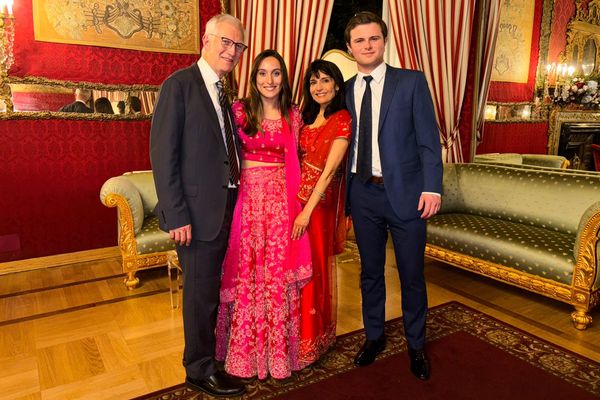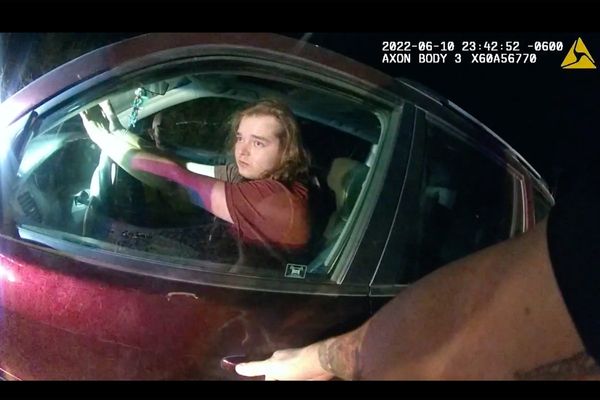
On April 10, 2005, Chris Mike was sitting in the basement of his Oregon home, watching the final round of the Masters like millions of others.
Then, when Tiger Woods had his iconic chip-in on Augusta National’s par-3 16th hole, he jumped up from his couch and began screaming—a reaction likely shared by many golf fans around the world.
Mike’s realization moments later, though, is what strayed from the masses.
“It was pure shock and amazement, but immediately after he hit that, I was sort of hit with the reality of the fact that things were gonna change for the next three to four weeks,” the former marketing director of Nike Golf recently told Sports Illustrated.
Emails started flying in hours after Woods slipped on the green jacket, and Mike estimates he didn’t stop working for several weeks.
It paid off—literally. With the Nike logo perfectly visible as the ball famously dropped into the cup, the company struck gold.
“I played with the guy who runs Nike Golf,” Rickie Fowler said in March at the Cognizant Classic, “and I know that was a pretty special moment for them because that was basically a commercial for them with the ball going in.”
Twenty years since the indelible chip-in, there’s now a generation barely old enough to remember watching it live—and that includes some of the world’s best golfers. But the moment remains in the public consciousness through other avenues.
“I mean, just a phenomenal ad opportunity for Nike there with that chip,” world No. 53 Ben Griffin said when SI asked him to reflect on the chip. “That’s the biggest memory from that one, I was 9 years old.”
An Immortal Moment
It couldn’t have been scripted better.
Woods led playing partner Chris DiMarco by a stroke when he pulled his tee shot with an 8-iron left of the 16th hole’s green. DiMarco, meanwhile, was facing an uphill 15-footer for birdie.
The ensuing moment is frozen in time—two decades later. Woods’s ball was on the fringe of the green, 30 feet from the hole. He chipped about 25 feet north of the pin, with the ball squirting across the putting surface and then taking a sharp right turn. It trickled closer and closer to the hole and hung on the lip of the cup for nearly two seconds, flashing the Nike swoosh, before dropping to an earthquake from the crowd.
“Oh, wow! In your life, have you seen anything like that?” Verne Lundquist exclaimed on the CBS broadcast, words that are now synonymous with the shot.
The greatest player on the grandest stage with a spine-chilling highlight for the ages—a perfect screenplay. Well, except maybe for the high five between Woods and his caddie, Steve Williams.
“Under the circumstances, it was one of the best I’ve ever hit,” Woods said afterward. “All of a sudden it was pretty good, then really good, then it was, ‘How can it not go in?’ Then it went in.”
Said DiMarco: “You expect the unexpected, and unfortunately, it’s not unexpected when he’s doing it.”
However, many forget what happened next.
“I don’t necessarily remember how (Woods) finished it off,” Griffin says, “but that chip’s one of the greatest shots in the history of all majors.”
Woods made bogey on No. 17 while DiMarco made par, cutting the margin back to one. On the final hole, Woods hit his third shot from the bunker to 10 feet, but missed his par putt to win. DiMarco made his, sending the duel to a sudden-death playoff.
Playing the par-4 18th again, Woods rolled in a 15-foot birdie for the win (how many times have you seen that on replay?) as DiMarco’s chip from almost the same distance as Woods’s earlier stopped a foot short.
Woods had won his first major since the 2002 U.S. Open—and the chip-in was the difference.
But despite the thrilling ending, all anyone could talk about was what happened on the 16th hole.
“For something like that to happen in golf that transcends sports and became part of popular sports culture,” Mike says, “whether you were a golf fan or not, everybody knew about it.”
And Nike was handed a marketing campaign on a silver platter.
“The fact that our product was front and center was pretty special,” Mike says.
Perfectly Imperfect
So what was the first course of action once Mike’s inbox began blowing up?
He and his team had a “win” strategy. Typically, when a Nike player won on Tour, they would meet Sunday night with their advertisement agency, Wieden+Kennedy, discuss what happened and choose what products they wanted to highlight for an ad that would appear in publications that week.
When a moment with the magnitude of Woods’s chip happens, that game plan is enhanced.
“We did TV commercials around it and then talked to our media buyers about purchasing the right amount of inventory around the right programming,” Mike says, “and this particular shot that (Woods) hit, he was using our wedge and so we wanted to highlight that his equipment was our equipment and then the ball that he was using.”
The commercial got off the map relatively quickly. Considering this wasn’t Nike’s first rodeo creating a promotional scheme, they knew who to call to acquire the licensing rights of the footage.
Instead, the biggest piece of the puzzle was figuring out how to tell the story of the chip in a way that felt Nike.
That included poking fun at Woods’s heroics.
“It was a perfect moment as it was,” Mike says, “but the only thing that would have made it more perfect was if the logo was horizontal versus vertical.”
Roughly two weeks after the Masters, their work was finished. The commercial aired during CBS’s coverage of the Zurich Classic and was also played on cable and Golf Channel.
It was bare, featuring the raw footage and audio of the chip with a witty message that read:
We gave you a wedge with more feel.
You showed us what it could do.
We gave you a ball with more control.
And you didn't center the logo?
Needing a quick turnaround, there wasn’t time to over-orchestrate a messaging strategy. But that was fine—not much needed to be said.
“The moment was as good as it gets.” Mike says, “Like, you couldn’t write that any better. So the idea was not to get in the way of that—it was to leverage it and just let it be. Sometimes, simplicity is the best answer for solving a problem like that.”
Yet, it wasn’t the most fulfilling campaign Mike worked on at Nike. Others that come to mind are the hacky sack ad, paying tribute to Earl Woods for Father’s Day during multiple U.S. Opens and the Tiger and Frank (which Tiger Woods called his headcover) series, to name a few.
“I don’t think it ranks up there as some of the best thoughtful and sort of targeted marketing that we’ve done,” says Mike, who worked with Nike for six years, ending in 2007. “That’s because it really was just sort of taking advantage of something that happened.”
Nevertheless, the approach was impactful.
The Tiger Effect
Nike hadn’t been in the golf equipment business long. Though Woods had been the company since “Hello, World” 1996, it didn’t begin manufacturing balls until the end of the 20th century (Woods first used it in competition during his 2000 U.S. Open win at Pebble Beach) and Nike’s clubs weren’t introduced until 2001.
“We were still growing and still sort of battling the competitors that were in that space,” Mike says, “and (Woods’s chip) gave us a massive boost in awareness and the fact that everybody was talking about our golf ball on Sunday and then for the next week was a huge opportunity.”
Entering the new millennium, Nike Golf was a $100 million company. Five years later, its value was nearly seven times that.
Profits, of course, spiked when Woods began using Nike’s equipment.
“Tiger was the ultimate billboard for all those products, as we used to say,” Stan Grissinger, Nike’s former business director of golf equipment, told SI.
During his chip-in, Woods was using a Nike Blade TW 60-degree wedge and the new One Platinum ball, which wouldn’t hit shelves until a month after the Masters. That didn’t matter—it sold out via pre-order.
“A brand moment like that,” Grissinger says, “one that’s as historic as it was and replayed as it was, it has a halo effect across all the product categories.”
For Mike, however, it wasn’t just about helping create a commercial. He had a lot more on his plate to help maximize revenue.
“Retail marketing, aligning with our salesforce to make sure that we had good account coverage and they knew what was coming because we wanted to take advantage of all that awareness and all that hype to drive sell-through,” he says.
“So we wanted to make sure the shelves were packed and stacked and faced properly and that there was plenty of product there. And then we wanted to make sure that all the communication and the signage at retail was pointing to our product. Then we had a PR effort surrounding it, an advertising effort surrounding it, so it was really a comprehensive sort of integrated plan that we had to make up on the run.”
In the following years, Nike Golf was on an upward trajectory—until it wasn’t
Despite signing other golf stars as brand ambassadors, such as Rory McIlroy, Brooks Koepka and Michelle Wie West, Nike stopped manufacturing golf equipment (not including apparel or footwear) in 2016. They’d still wear the brand, but had to find new clubs to fill their bag with.
A year later, Nike co-founder Phil Knight told Bloomberg, “It’s a fairly simple equation, that we lost money for 20 years on equipment and balls.”
Then, in 2024, Woods and Nike split after 27 years—something that once seemed inconceivable.
“It was definitely disappointing,” says Grissinger, who last worked at Nike in 2017 after 18 years, “but you had so many great memories from the previous 20-plus years he was in the brand, and you reflect on those and you still feel really good about the whole relationship and the experience.”
And the zenith of that partnership was arguably when Woods’s ball dribbled into the cup 20 years ago.
But two decades since Mike leaped off his basement couch, he is surprised that people are still talking about Nike’s pivot of the cinematic moment.
“(Woods) basically created the momentum.” Mike says, “He rolled the snowball off the hill, and it was our job to really build an entire comprehensive plan around that.”
This article was originally published on www.si.com as How Tiger Woods’s Classic Masters Chip-in 20 Years Ago Became a Dream for Nike .







